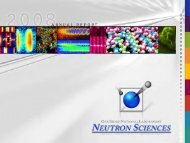Powder Diffraction - Spallation Neutron Source
Powder Diffraction - Spallation Neutron Source
Powder Diffraction - Spallation Neutron Source
You also want an ePaper? Increase the reach of your titles
YUMPU automatically turns print PDFs into web optimized ePapers that Google loves.
Fitting crystallographic data -- what is it all about?<br />
We perform an experiment:<br />
– Get lots of intensity and position measurements in a diffraction<br />
measurement: what do they tell us?<br />
Obtain an unit cell that fits the diffraction positions (indexing)<br />
“Solve the structure”: determine an approximate model to match the<br />
intensities<br />
Add/modify the structure for completeness & chemical sense<br />
Optimize the structure (model) to obtain the best fit to the observed data<br />
– This is usually done with Gauss-Newton least-squares fitting<br />
– Parameters to be fit are structural and may account for other experimental<br />
effects<br />
Least Squares gives us a Hessian matrix; inverse is variance-covariance<br />
matrix which gives uncertainties in the parameters<br />
40
















